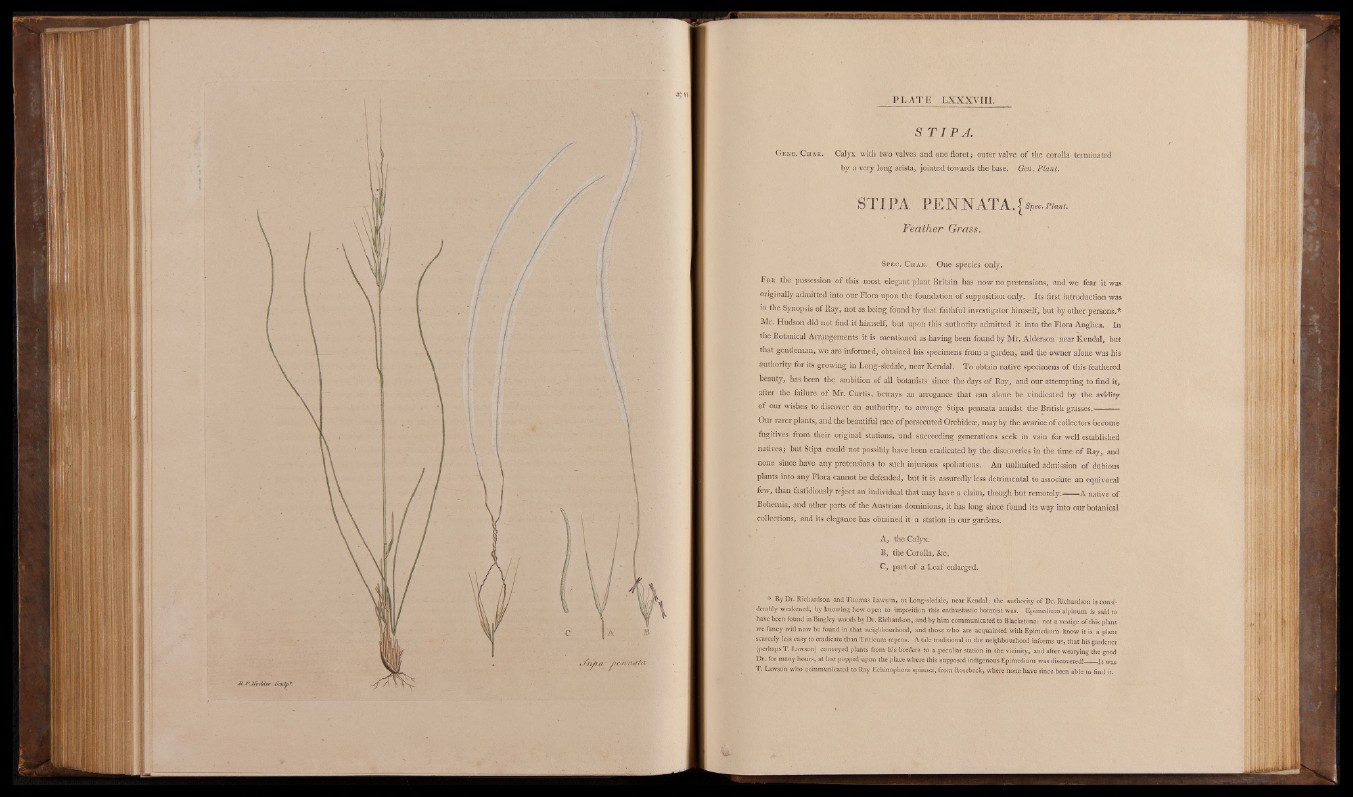
■ ■ ■ ■ ■
P L A T E LX X X V I I I .
5 T I P A .
Gene. Char. Calyx with two valves and one flore tou ter valve o f the corolla terminated
by a very long arista, jointed, towards the base. Gen. Plant. '
STIPA PENNATA.{spec.pum.
Feather Grass.
Spec. Char. One species only.
For the possession of this most elegant plant Britain has now no pretensions, and we fear it was
originally admitted into, our Flora upon the foundation o f supposition only. Its first introduction was
in the Synopsis of Iiay, not as being found by that faithful investigator himself, but by other persons.*
Mr. Hudsoi^ did not find it himself, but upon this authority admitted 'it into the Flora Anglica. In
the Botanical Arrangements it is mentioned as having been found by Mr. Alderson near Kendal, but
that gentleman, we are informed, obtained his specimens from a garden, and the owner alone was his
authority for its growing in Long-sledale, near Kendal. To obtain native specimens o f this feathered
beauty, has been the ambition of all botanists since the days of Ray, and our attempting to find it,
after the failure o f Mr. Curtis, betrays an arrogance that can alone be vindicated by the avidity
of our wishes to discover an authority, to arrange Stipa pennata amidst the British grasses.
Our rarer plants, and the beautiful race of persecuted Orchideae, may by the avarice o f collectors become
fugitives from their original stations, "and succeeding generations seek in vain for well established
natives | but Stipa could not possibly have been eradicated by the discoveries in the time of Ray, and
none since have any pretensions to such injurious spoliations. An unlimited admission o f dubious
plants into any Flora cannot be defended, but it is assuredly less detrimental to associate an equivocal
few, than fastidiously reject an individual that may have a claim, though but remotely.------A native o f
Bohemia, and other parts of the Austrian dominions, it has long since found its way into our botanical
collections, and its elegance has obtained it a station in our gardens.
A, the Calyx.
B, the Corolla, &c.
C, part of a Leaf enlarged.
* By Dr. Richardson and Thomas Lawson, at Long-sledale, near Kendal: the authority of Dr. Richardson is const1
derably weakened, by knowing how open to imposition this enthusiastic botanist was. Epimedium alpinum is said to
have been found in Bingley woods by Dr. Richardson, and by him communicated to Blackstone: not a vestige of this plant
we fancy will now be found in that neighbourhood, and those who are acquainted with Epimedium know it is a plant
scarcely less easy to eradicate than Triticum repens. A tale traditional in the neighbourhood informs us, that his gardener
(perhaps T. Lawson) conveyed plants from his borders to a peculiar station in the vicinity, and after wearying the good
Dr. for many hours, at last popped upon the place where this supposed indigenous Epimedium was discovered!—s—J t was
T. Lawson who communicated to Ray Ecliinophora spinosd, from Roscbeck, where none have since been able to find it..